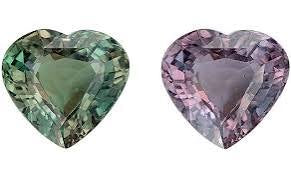Sigrid's blog
We are very excited! We have added a very special stone to our collection: "LAB GROWN ALEXANDRITE". And to be honest: it is my favorite!
As a goldsmith's wife I am lucky to see and be able to hold the most beautiful stones. And Alexandrite and Opal are beyond precious. Not 2 stones are similar and -depending of the light- are different each time you look at them.
It is a stone with a beautiful history and what makes it so special is the fact the stone changes color!
**Emerald by day, Ruby by night**
We have got the lab grown Alexandrite stone in our collection in a heart shaped stone (see picture). Shop this marvellous stone now, placed in these handmade keys! SHOP NOW
We have got the lab grown Alexandrite stone in our collection in a heart shaped stone (see picture). Shop this marvellous stone now, placed in these handmade keys! SHOP NOW
Alexandrite is a variety of chrysoberyl. Due to the presence of oxide of chromium, it appears dull grass-green by daylight (which is rich in blue rays), but by electric light it appears yellowish or reddish-yellow, and by soft candle-light (which is rich in red rays) it appears reddish/purple.



It is highly dichroic. Its original source was near Ekaterinburg, in the Ural Mountains of Russia.
The stone was discovered there in 1830, the year Alexander II came of age; hence it was named after him.

The variety now found in Sri Lanka (formerly Ceylon) changes from dark olive-green to brownish-red; it is larger than that of Russia (which is bluer) but less valuable.
The alexandrite variety displays a color change (alexandrite effect) dependent upon light, along with strong pleochroism. Alexandrite results from small scale replacement of aluminium by chromium oxide, which is responsible for alexandrite's characteristic green to red and purple color change. Alexandrite from the Ural Mountains in Russia is green by daylight and red by incandescent light. Other varieties of alexandrite may be yellowish or pink in daylight and a columbine or raspberry red by incandescent light. The optimum or "ideal" color change would be fine emerald green to fine purplish red, but this is exceedingly rare. Because of their rarity and the color change capability, "ideal" alexandrite gems are some of the most expensive in the world.
According to a widely popular but controversial story, alexandrite was discovered by the Finnish mineralogist Nils Gustaf Nordenskiöld, (1792 -1866) on the tsarevitch Alexander's sixteenth birthday on April 17, 1834 and named alexandrite in honor of the future Tsar Alexander II of Russia. Sometimes, Nils Gustaf Nordenskiöld is confused with his son, Adolf Erik Nordenskjöld (1832–1901), also a famous Finnish geologist, mineralogist and arctic explorer who accompanied his father to the Ural Mountains to study the iron and copper mines at Tagilsk in 1853. However, Adolf Erik Nordenskjöld was only two years old when Alexandrite was discovered and only ten years old when a description of the stone was published under the name of Alexandrite for the first time. Small detail is, he thought he had found an emerald at first. Confused with the high hardness however, he decided to continue his examinations. Later that evening, while looking at the specimen under candlelight, he was surprised to see that the color of the stone had changed to raspberry-red instead of green. Later, he confirmed the discovery of a new variety of chrysoberyl, and suggested the name "diaphanite" (from the Greek "di-", twi- and "aphanès", inapparent
The largest cut stones being in the 30 carat (6 g) range, though many fine examples have been discovered in Sri Lanka (up to 65 cts.), India (Andhra Pradesh), Brazil, Myanmar, and especially Zimbabwe (small stones usually under 1 carat (200 mg) but with intense color change). Overall, stones from any locale over 5 carats (1 g) would be considered extremely rare, especially gems with fine color change. Alexandrites have two primary value drivers. First, the closer the colors to pure green and red, the higher the value. Second, the more distinct the color change, the higher the value. Alexandrites can exhibit everything from 100% to just 5% color change. Thus, the most valuable gems would have a 100% color shift from pure green to pure red. Blue-greens and purplish or brownish reds hold less value.It is the birthstone of the month of June. Alexandrite is both hard and tough, making it very well suited to wear in jewelry.


We have a limited stock at the moment as the Alexandrite is very rare. Therefore it will take a bit longer than usual to manufacture your key with this extraordinary stone: approximately 2 weeks instead of 1.
Thank you for reading, Sigrid

